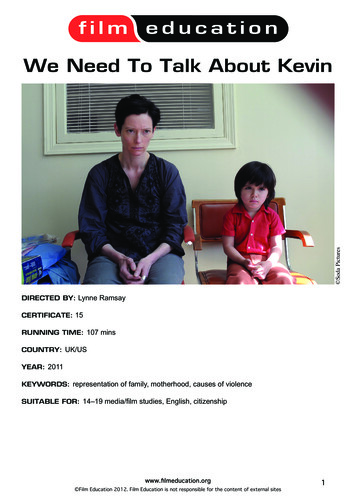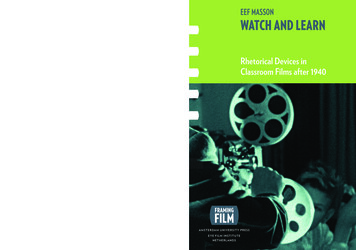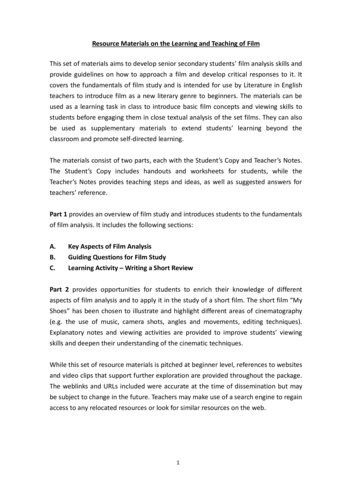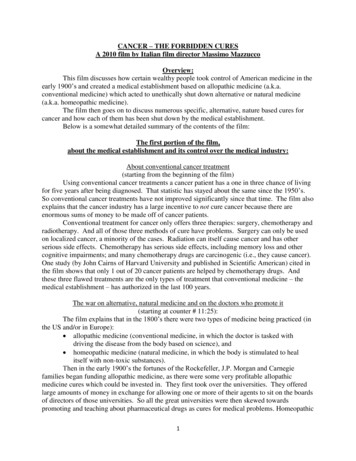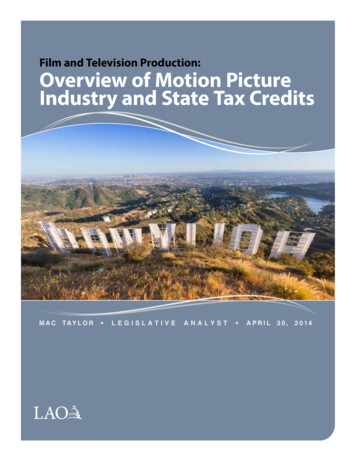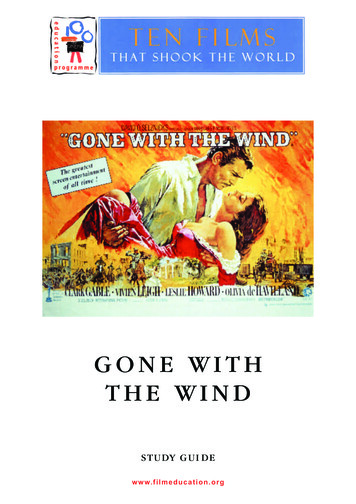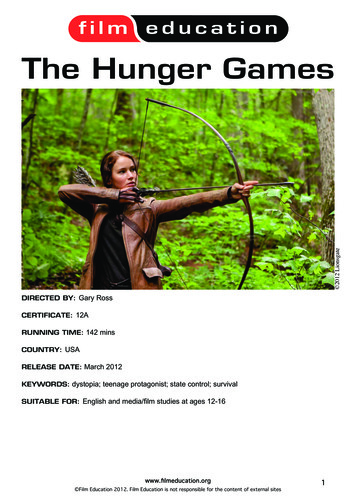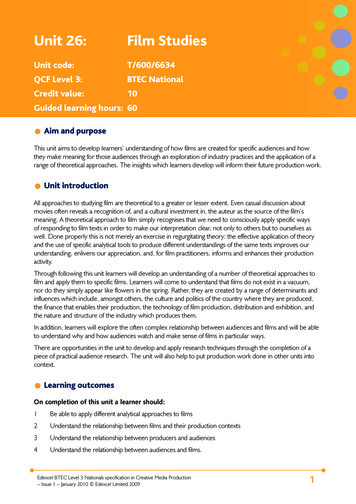
Transcription
PSYCHOS T U DY G U I D Ewww.filmeducation.org
PSYCHOTEACHERS’ NOTESThis study guide is aimed at students of GCSE Media Studies, A Level Media Studies, A LevelFilm Studies and GNVQ Media: Communication and Production (Intermediate andAdvanced).The guide looks at Alfred Hitchcock as a director and producer; narrative structure;characterisation; the use of music, motifs and irony; promotion of the film and problems ofcensorship.Psycho: Certificate 15. Running Time 109 minutes.MAJOR CREDITSPsycho 1960 (Paramount)Producer:Director:Screenplay:Director of Photography:Editor:Music:Art Directors:Cast:Oscar Nominations 1960:FORPSYCHOAlfred HitchcockAlfred HitchcockJoseph StefanoJohn L. RussellGeorge TomasiniBernard HerrmannJoseph HurleyRobert ClatworthyAnthony PerkinsJanet LeighVera MilesJohn GavinMartin BalsamJohn MeintireBest DirectorBest Supporting Actress (Janet Leigh)Best B/W CinematographyBest B/W Art Directionwww.filmeducation.org Film Education. Film Education is not responsible for the content of external sites.2
PSYCHOINTRODUCTIONBYDEREK MALCOLMMany filmmakers would say that there’s no such thing as a movie capable of shaking theworld. But some still attempt to make them. Those who succeed are rare, and the strangething is that even the lucky ones don’t appear to know they are doing it at the time. In fact, itsometimes takes years to realise what really is a great film or what may have looked wonderfulat the time but was just a momentary flourish.Most of the films on this particular list didn’t so much shake the world as becomememorable because, when you look back on them, they seem so much better than we mayhave thought at the time. But memories are short and the opportunity to see the full floweringof cinema history is denied to all but a few. So the list looks a little unbalanced to me, whohas been luckier than most in looking further into the past and at world cinema rather thanjust Hollywood.What we get here are films that were certainly important in their time, and still look goodtoday- movies that have remained in people’s affections ever since they first saw them. If therearen’t really enough from the first two-thirds of cinema history, no matter. Its good at least toknow that some of the greatest directors in the world are represented and that their artistry,often the equivalent of any great playwright, painter, author or composer of the twentiethcentury, continues to he appreciated. Most of these films will live longer than we do.PSYCHOIf Welles was a master, so was the far more prolific Alfred Hitchcock, once thought of as merelya great but shallow entertainer. He was a subtle craftsman who elevated his low cunning intohigh art. Psycho may not have been his best or most sophisticated film but it has become oneof his most popular and successful. It has been described as the mother of the modern horrormovie. But, if so, she’s spawned some odd children. What isn’t often recognised is that Psychowas a distinct change of pace by Hitchcock, who reverted to black and white from colour andhad to put up with the kind of constraints that were imposed upon him by his TV series, AlfredHitchcock Presents. The result really did shake the world, with its black sense of humour andits textbook example of how to manipulate an audience into fear and loathing. But the filmwas also a critique of the cruelty of life – it was actually based on the history of thecannibalistic Wisconsin killer Ed Gein, as was the much later Texas Chainsaw Massacre. Butagain, this is a collaborative effort. Even the famous shower scene, put together by Saul Bass,would have been much less effective without Bernard Herrmann's nerve-wracking score.Hitchcock was a dab hand at perversity, but he had some pretty able helpers.www.filmeducation.org Film Education. Film Education is not responsible for the content of external sites.3
PSYCHOK INTRODUCTION KAlfred Hitchcock’s Psycho was first screened in New York on 16 June 1960. It was animmediate box-office success. From the start, expectant filmgoers began queuing in Broadwayat 8.00am setting a pattern for audiences worldwide. By the end of its first year, Psycho hadearned 15 million – over fifteen times as much as it cost to make.Psycho was a watershed in many ways. As well as making Alfred Hitchcock amultimillionaire, it was to win huge critical acclaim and enshrine him as a master filmmaker.It generated two sequels itself and set down a formula for ‘madman with knife’ films,shamelessly copying its film techniques. It also influenced the makers of many of the mostwell-known modern horror and suspense films, ranging from Halloween to Fatal Attraction.Psycho’s commercial success was due, in part, to a superbly orchestrated publicity andmarketing campaign that set new standards for audience manipulation. Hitchcock insistedpeople alter their cinema-going habits if they wished to see his film, and in doing so, hehelped create film-viewing conventions that we now take for granted.It is claimed that the film reflected, or contributed to, a growing permissiveness in society:its violence, sexual content and even the flushing of a toilet on screen, all breaking newground for mainstream Hollywood film. Its themes struck at many cherished American values;mother love, in particular, would never be quite the same again. Following its release, Psychowas even blamed in court for being the cause of a number of horrible murders, stimulating adebate about the links between screen violence and anti-social behaviour that continuesunabated to this day.www.filmeducation.org Film Education. Film Education is not responsible for the content of external sites.4
PSYCHOK E X P E C TAT I O N S KIt is impossible to recreate the experience of the audiences who first flocked to see Psycho,unsure of what they were about to witness. Even if you have not already seen Psycho, you maywell have heard a great deal about it – even its ending – but before you watch it in class, tryto describe what expectations you have of the film.TaskWhat ideas does the title 'Psycho' bring to mind? What emotions does the title create in you– excitement, dread, curiosity? Try to explain your response.Look at the poster for the film on the cover of this guide. What do you notice about thelettering in the title graphics? What effect does the word 'psycho' have on you? Does it add toyour expectations of the film? What does it suggest about the mind of or behaviour we canexpect from the person it refers to?Psycho was released in 1960. Do you expect that it will be old fashioned? In what ways?K HITCHCOCK-DIRECTOR AND PRODUCER KWhen you hear the name Steven Spielberg, what kind of filmwould you expect to see? If you can answer this question, you willunderstand the similar power that Alfred Hitchcock had over thecinema-going public in 1959, when he decided to make Psycho, his47th film.Hitchcock’s directing career started in 1922. By 1959 he was oneof Hollywood’s best-known personalities. His films often containeda short personal appearance by him as an extra, sometimes carryingor wearing something that drew attention to his size or made himlook silly. In Psycho he is the man in the Stetson standing on thestreet, who glances at Marion Crane as she returns late from herlong lunch break with Sam. His television programme, AlfredHitchcock Presents, was amongst the top ten shows then being screened and his humorous,but rather twisted introductions to these Sunday night mystery dramas, further increased hisreputation for the unusual and the macabre.The book by Robert Bloch based on the real-ife killings of psychopath Ed Gein in Plainfield,Wisconsin, had already been rejected by Paramount Studios as ‘impossible to film ‘, whenHitchcock paid 9,000 for the film rights. Paramount were horrified that Hitchcock shouldconsider Psycho suitable material, and did everything they could to put him off; even claimingthat there was no Paramount studio space available for him to use.Hitchcock was determined to film Psycho and came up with a financial formula that evenParamount could not refuse. He agreed to pay for the film himself and give up his usual 250,000 director’s fee. He even arranged to make the film using facilities at Paramount’s rivalstudio, Universal International. In exchange, Paramount agreed to promote and distribute thefilm and give Hitchcock sixty per cent ownership of the final negative.www.filmeducation.org Film Education. Film Education is not responsible for the content of external sites.5
PSYCHOK T H E F I L M I N G O F P S YC H O KIn his role as both director and producer, Hitchcock was in the privileged position of havinga great deal of involvement in the actual planning and filming of Psycho. His originality in thisarea contributed greatly to the unique nature of the film.TaskThe following section of the Psycho script describes Lila's approach to the Bates' house fromthe motel, near the end of the film. The words in capital letters are the camera instructionsthat Hitchcock added. Compare it to the actual sequence in the film. How similar is thescreenplay to the finished product? What differences can you see? What does this tell youabout Hitchcock’s pre-planning before the filming began? (A subjective shot reproduces theviewpoint of the character; it is as if we are looking through their eyes). What does the musicadd to the scene?How different wouldthis scene have been ifEXTERIOR. REAR OF MOTEL - S.C.U. [SUBJECTIVE CLOSE-UP] - DAYHitchcock had put theBehind the motel Lila hesitates. She looks aheadcamera in one placeLONG SHOT - DAYand filmed Lila as sheThe old house standing against the sky.walked up to the houseCLOSE-UPfrom one position only?Lila moves forward.What would be lostfrom the sequence?LONG SHOTTake another shortLila approaches the house.sequence from anyCLOSE-UPwhere in the film inLila glances towards the back of Norman’s parlour. She moveswhich there is no soundon.(e.g. Marion packing toleave with the money).LONG SHOTCreate your own bitThe house coming nearer.of Psycho screenplay byCLOSE-UPdescribing the thingsLila looks up at the house. She moves forward purposefully.you see and adding thecamera instructions.SUBJECTIVE SHOTThe house and the porch [come into view].CLOSE-UPLila stops at the house and looks up. She glances back.She turns to the house again.SUBJECTIVE SHOT[Lila] mounts the steps of the porch.CLOSE-UPLila puts out her hand.SUBJECTIVE CLOSE-UPLila’s hand pushes the door open. We see the hallway.Lila enters.[LILA ENTERS] PAST CAMERAwww.filmeducation.org Film Education. Film Education is not responsible for the content of external sites.6
PSYCHOHitchcock made no secret of his methods of using the camera to tell a story and affect theemotions of his audience:‘The point is to draw the audience right inside the situation instead of leavingthem to watch it from outside, from a distance. And you can do this only by breakingthe action into details and cutting from one to the other, so that each detail is forcedin turn on the attention of the audience and reveals its psychological meaning.’My Own Methods, Hitchcock, 1937.In Psycho this approach reaches its peak ofperfection in the two murder scenes. Therewere censorship reasons that made thequick-fire cutting of the shower scenenecessary, but Hitchcock’s principal concernwas to disturb the audience and to suggestterrible violence and bloodshed withoutactually showing very much.TaskUse the plan below of thebathroom in Psycho to workout where the camera had tobe positioned during thefilming. Run the shower sceneand freeze it at various points.Put a number on the plancorresponding to the cameraposition needed to catch eachshot. What technical problemscan you imagine the film crewhad to overcome?There were actually 78 separate camera set-ups needed for the shower scene and it tookseven days to film. Among the technical headaches were the problems of keeping pieces ofmoleskin glued to Janet Leigh (Marion) to prevent her appearing nude; filming the head-onshots of the water pouring out of the shower (solved by blocking some of the central showerholes and using a long lens to prevent the camera being soaked, although the camera crewwere less fortunate) and filming ‘Mother’ from inside the shower. The walls on each side ofthe shower were detachable to enable the crew to film Marion’s demise from every possibleangle.www.filmeducation.org Film Education. Film Education is not responsible for the content of external sites.7
PSYCHOK THE MUSIC KMusic plays a crucial part in Psycho. The score was created by Bernard Herrmann and is nevermore effective than in the shower scene. In fact Hitchcock had wanted the sequence to appearin silence and later on it was proposed jazz music should accompany the images. Herrmannhad the idea of just using string instruments, violins played at a very high pitch evoking thestabbing actions of ’ the knife and Marion’s screams.TaskWatch the shower sequence with the volume turned down. What is missing from the scene?In what ways does Herrmann's music complement the actions of 'Mother', the reactions ofMarion and the way the film is edited?K T H E F O R M O F P S YC H O KWhen a work of art such as a film like Psycho is said to have form, it is the overall relationship,the shapes and patterns created by the various elements that make up the film, which is beingreferred to. One reason for Psycho’s popularity is the fact that it is a very complex film, it isfull of links and connections, and because of its intricate form it’s usually possible to seesomething new each time you watch it.THE STORY STRUCTUREThe idea of starting the story with a woman escaping with money, who comes to a sticky endin a motel shower, was in the original Robert Bloch novel, but it was Hitchcock’s screenwriterJoseph Stefano who really recognised the shock potential of this story structure. It was he whodecided to devote nearly a third of ’ the film to her and her problems, getting the audience onher side, only to bump her off and leave everyone unsure of where they were or with whomto identify.TaskPsycho is unusual in having not just one story, but also several, some of which lead tocomplete dead ends. Put this to the test by using the diagram below and fill in the specificstory elements for the following characters: MARION CRANE, MILTON ARBOGAST (the privateinvestigator), NORMAN BATES (from the moment he discovers Marion's body) and LILACRANE.CharacterProblem causedby agent of change.Agent of change:The person, desire orthing that disruptscharacter’s lifeQuest – the waycharacter sets aboutsolving problem.www.filmeducation.org Film Education. Film Education is not responsible for the content of external sites.Resolution.Any loose ends?8
PSYCHOK C H A R A C T E R I S AT I O N KThe people we see on screen in Psycho arecharacters created at first by a writer and theninterpreted by actors cast to play the roles. Thismay seem a painfully obvious point. But the factthat their performances can convince or move usis a tribute to the lines they are given to speakand their capacity to represent their characterseffectively.What this means is that they present theformal elements that make up a character - voice,expressions, body language etc. - in a consistentand meaningful way. If ’ Anthony Perkins(Norman Bates) began winking at us or keptreminding us that he was not really a murderer,then we would quickly cease to be involved inthe drama of his situation and probably start tolaugh at these Monty Python-like developments.TaskLook at the following point-of-view shots.Remember that at each moment we are meant to feel we are seeing things through the eyesof a character. What emotions do we experience alongside them and how do the shotscontribute to our feelings for the character? Are we made to experience sights that implicateus, make us share the guilt or voyeurism of certain characters?SHOTEMOTIONS CHARACTER/AUDIENCE SHAREMarion's view of the stolen money on her bedMarion's car window view of her employerwww.filmeducation.org Film Education. Film Education is not responsible for the content of external sites.9
PSYCHOMarion's view of policemanNorman's peephole view of MarionNorman's view of newspaperNorman's view of car failing to sinkLila's view of Mrs Bates' bedLila's view of Mrs Bateswww.filmeducation.org Film Education. Film Education is not responsible for the content of external sites.10
PSYCHOK REPETITION KHitchcock planned every part of Psycho long before the filming began and little that is in thefilm is there by accident. To give a story shape, a director may often include repetitions;events, themes or even objects that keep turning up. Psycho is full of such repetitions ormotifs. Motifs are often a helpful way of discovering the deeper meanings of a film and Psychois no exception. For instance, what significance can you spot in the change of Marion’sunderwear before/after her crime?One of the most significant motifs concerns the theme of doubleness and centres on mirrorimages.TaskFast forward through the film and watch the following scenes in which mirrors occur:K Marion packing her bagsK Marion in the second-hand car lot's lavatoryK Marion's view of her eyes in the rear view mirror as shedrivesK Marion as she checks into the Bates’ MotelK Arbogast as he questions Norman about Marion'sdisappearanceK Lila and Sam as they check into the Bates’ MotelK Lila in Mrs Bates' bedroomAt each of these moments ask yourself what the character isthinking, planning or pretending to be, just as a doubleimage of them is on the screen. What is the big differencebetween Lila's reaction to her mirror image and Marion'sresponse to hers? What does this reveal about theircharacters?TaskLook out for other repetitions in Psycho, for instance the discussion of marriage in the officescene when Marion returns to work after her long lunch break with Sam, or movementsinvolving anyone talking of or actually being watched and observed. How do these motifsadd to an understanding of the character, their behaviour or the overall atmosphere of thefilm?TaskRepetition also has a great deal to do with the way in which Hitchcock builds suspense inPsycho. When Lila explores in the Bates' home, half the tension is created by what we havealready seen happen in that spooky house. Look at her exploration and think how what wealready know or have seen adds to our sense of dread.SIMILARITY AND DIFFERENCEA film that constantly repeats itself might become very dull. Think how much less scaryArbogast’s murder would be if he had been stabbed having a shower too. When Sam goes tothe Bates’ Motel to look for Arbogast for the first time and finds the place deserted, Hitchcockfilms Norman standing by the swamp. He avoids showing a second sinking car scene, leavingit to our imagination and memories to fill in the gaps.www.filmeducation.org Film Education. Film Education is not responsible for the content of external sites.11
PSYCHOA formal device used to give a film shape without making it predictable is the repeated useof something in different circumstances or for different purposes. The 'something’ can be agesture, an expression, an object, a set of actions, anything.TaskDiscuss the different jobs and functions that the following objects perform during Psycho.Part of the function of a motif might be the effect it has on us or the contribution it makesto the atmosphere of the film.K newspaper Marion buys at the used car lotK shower curtainK birdsTaskCritics have pointed out that in keeping with the visual motif of reflections, the whole filmis like a mirror with the events in the Marion part being duplicated in the Norman sectionof the film. If so, then the Norman side of the mirror offers a very distorted image of Marion'sworld in which similar actions take on an altogether more disturbing aspect. The joinbetween the two worlds can be pin-pointed at the moment Marion hesitates and signs a falsename in the register followed immediately by Norman's inexplicable hesitation and thenselection of the key for room number one.Study the scene in which Marion packs her bags and then the scene in which Norman clearsup the murder. What similarities can you spot and in what ways do the similar actions orevents have very different meanings in the two worlds. In particular, how does the moneychange in significance after Marion’s death?IRONYAnother powerful tool for lending a film or any story shape is irony. Dramatic irony is createdwhen an audience knows more about events than the characters in a film and can anticipatewhat is about to happen. Irony can also occur when something acquires a greater significanceon second hearing or seeing because it seems to hint at what is going to occur later on.TaskDiscuss moments in the film when you knowmore about what is going on than acharacter or characters. How does this'knowledge' contribute to your experience orenjoyment of the film? Does it add to thesuspense? Even though you know more thana character such as Arbogast as he climbsthe stairs, what does Hitchcock do to ensurethat we still experience shock in this scene?How important is dramatic irony in asuspense film?www.filmeducation.org Film Education. Film Education is not responsible for the content of external sites.12
PSYCHOTaskThe following is a list of some of the ironic lines that pepper the script. In each case, commenton the added significance of the line now you know the whole film.SCENESCRIPTIRONIC EFFECTMarion to Sam in hotel room ‘Checking out time in thesekinds of hotels is 3.30 andwhen your time's up Traffic cop to Marion‘There are plenty of motelsin this area I mean justto be safe.’California Charlie to Marion‘The first customer is alwaysthe most trouble ’Marion imagining Cassidy’s‘I'll get it back and if any offury on the Monday after the it's missing, I'll replace ittheftwith her fine soft flesh.’Norman excusing hismother’s 'outburst' toMarion‘What's the phrase she isn'tquite herself today.’Norman to Marion duringtheir supper together‘A boy's best friend is hismother.’Old lady in Sam’s storetalking to assistant aboutinsect poison‘Death should always bepainless.’Norman to Arbogast‘Old habits die hard. ‘www.filmeducation.org Film Education. Film Education is not responsible for the content of external sites.13
PSYCHOIrony does not have to be verbal. Psycho is full of ironic visual hints also that add to theenjoyment of the film each time you see it.TaskStudy the still of Marion in her office being shown the 40,000 and the long shot of Normannear the swamp. Look at the bottom of the picture just seen on the wall behind Marion. Canyou see a link between this and the place where Norman is standing? What do theselandscapes say about the characters and their circumstances and how does the pictureironically hint at Marion's fate? What does the tree resemble? Can you think of anysignificance in its shape to the character of Norman?K PROMOTING THE FILM KSome films succeed by chance. Word of mouth creates good audiences and profits. Other filmsare heavily advertised and promoted then vanish without trace. In the words of WilliamGoldman, when it comes to guessing which films will work or not: ‘Nobody knows anything.’At the first screening of Psycho in a rough-cut version without the Herrmann soundtrack,Hitchcock was allegedly so disappointed with the film that he wanted to cut it down and makeit into a television show. Luckily, he was dissuaded.On the other hand, Hitchcock was a master of publicity and the promotion of Psycho wasto prove a masterclass of audience manipulation.Hitchcock’s publicity tasks started as soon as he bought the rights to Robert Bloch’s novel.Publicity can be generated at all phases of the film production process. It can occur in preproduction when the screenplay is being written and the actors and technicians are beingcontracted. It can happen during production of the film and it is essential in post production whenit ties in with the distribution of the film to generate the audiences for the cinemas showing it.KEY OBJECTIVESHitchcock’s first task was to keep the story of Psycho a secret during filming, but at the sametime generate curiosity about the project. Secondly, he needed to ensure that the film criticsand first audiences did not give the story away so as to keep the film’s shocking end a surpriseand to ensure the film had legs - growing audience interest after the initial opening.www.filmeducation.org Film Education. Film Education is not responsible for the content of external sites.14
PSYCHOTask 1Divide into groups and share out the responsibilities of promoting Psycho during the threemain phases of its creation, bearing in mind the key objectives mentioned on the previouspage. Be as specific as you can; if you decide to create a poster; what images from the filmwould you use and why?Task 2The following is a list of various publicity stunts that might have occurred during themaking and distribution of Psycho. Using your judgement, decide at which stage in the filmsuch events might have happened: pre-production, production or post production and whichof them are true or false.The actors were made to swear an oath of secrecy on the first day of filming.Hitchcock refused to let Paramount’s studio photographers onto the set to take publicityshots.Hitchcock insisted that if cinemas were to show Psycho they would have to control the waythe audience saw the film. The conditions were made part of the contract that cinemaowners had to agree to before receiving a print of the film to screen. [At a time when a filmprogramme might involve a newsreel, a support film or B-movie, and the main feature,audiences were used to turning up at any time during a programme and sitting through ituntil it went full circle.] Hitchcock demanded that Psycho should be shown at specifictimes, and that tickets for each separate performance could be pre-booked. He alsodemanded that no one be admitted once the film had begun. This inevitably led to longqueues outside cinemas showing the film, a kind of publicity in its own right, and ensuredthat no one could see the film from half-way through, thus ruining the effect of the showerscene.When he bought the film rights to Psycho he sent his aids to bookstalls to buy up as manycopies of the book as they could.Hitchcock made a series of misleading statements to the press. At one time it was thoughthe was filming a version of the Greek myth of Psyche, and he told one Hollywood reporter:‘It’s the story of a young man whose mother is a homicidal maniac.’The film poster, on page one, avoided showing anything of the murders, but concentratedon the sexual explicitness contained in the film with a prominent picture of Janet Leigh ina bra and John Gavin (Sam Loomis) with a naked chest.As people left the cinema a tape recording of Alfred Hitchcock asking them not to reveal theending of the film because ‘it’s the only one we’ve got’ was broadcast in the foyer.Hitchcock tried explicitly to make his public part of the publicity strategy.www.filmeducation.org Film Education. Film Education is not responsible for the content of external sites.15
PSYCHOHitchcock produced a six-minute trailer in which he acted as tour guide to the Bates’ moteland house. He referred to the two murders and to Norman’s mother, but otherwise hedescribed everything in a vague and suggestive way, pretending to be too squeamish todivulge certain details.Contacted by the manager of Woods Theatre in Chicago who was worried that rain wasinfuriating crowds standing outside the cinema, Hitchcock suggested they should bebought umbrellas and a publicity stunt could be generated out of the event. The story madeheadlines the following day.Hitchcock did not allow critics to see the film at special screenings. They had to join thequeues and see the film along with ordinary cinemagoers. In their press packs they werespecifically asked not to reveal the film’s ending. In a famous review of Psycho written in1968 when the film first appeared on television in Britain, Kenneth Tynan (critic felt thatHitchcock bruised critics’ egos by treating them in this way and that this was one cause forthe film’s many bad initial reviews.Janet Leigh refused to attend the film in a public theatre because she felt her presencewould detract from the film’s effect.Managers at cinemas were sent a publicity pack, with advice on how to go about hiringsecurity guards to keep the crowds in order, and how to screen the film. Instructionsincluded keeping cinemas dark for thirty seconds after the film’s screening and shininggreen light on people as they left the auditorium.Hitchcock had a chair on set throughout filming with the name ‘Mrs Bates ‘ on the back.He even posed in the chair himself for publicity shots. Other pictures had characters staringfearfully at an empty rocking chair.Task 1Write a script for Hitchcock's famous trailer in whichhe goes on a tour of the Bates' motel and house. Wherewould you go and what would you say withoutrevealing too much but whetting the appetite of thepublic?Task 2You are Alfred Hitchcock writing a letter to HerbSteinberg, Head of Publicity at Paramount, setting outthe publicity strategy for Psycho. You are welcome toborrow from the actual promotion tactics employedand add your own ideas. Include any poster designs ormerchandising ideas you feel might work.www.filmeducation.org Film Education. Film Education is not responsible for the content of external sites.16
PSYCHOK CENSORSHIP KIn 1960 censorship in America was much stricter than today. All screenplays and films had togain approval from the Motion Picture Association that enforced a code of ethics, originallyestablished in 1930 by the Hayes Office (named after its first boss, ex-postmaster general, WillH. Hayes). If a film failed to be approved, it was very unlikely to be shown in most cinemasand probably would not even be made. In 1960
of Psycho screenplay by describing the things you see and adding the camera instructions. PSYCHO www.filmeducation.org Film Education. Film Education is not responsible for the content of external sites. 6 EXTERIOR. REAR OF MOTEL - S.C.U. [S UBJECTIVE CLOSE-UP] - DAY Behind the motel Lila hesitates. She looks ahead LONG SHOT - DAY
